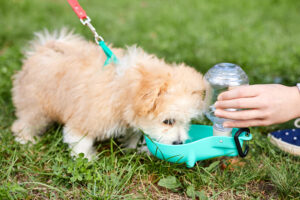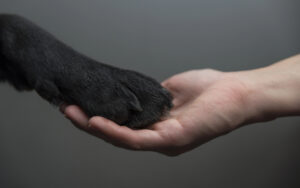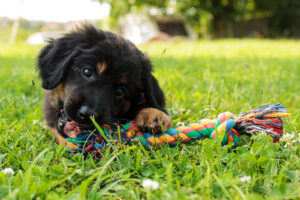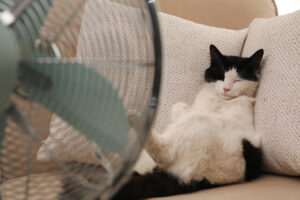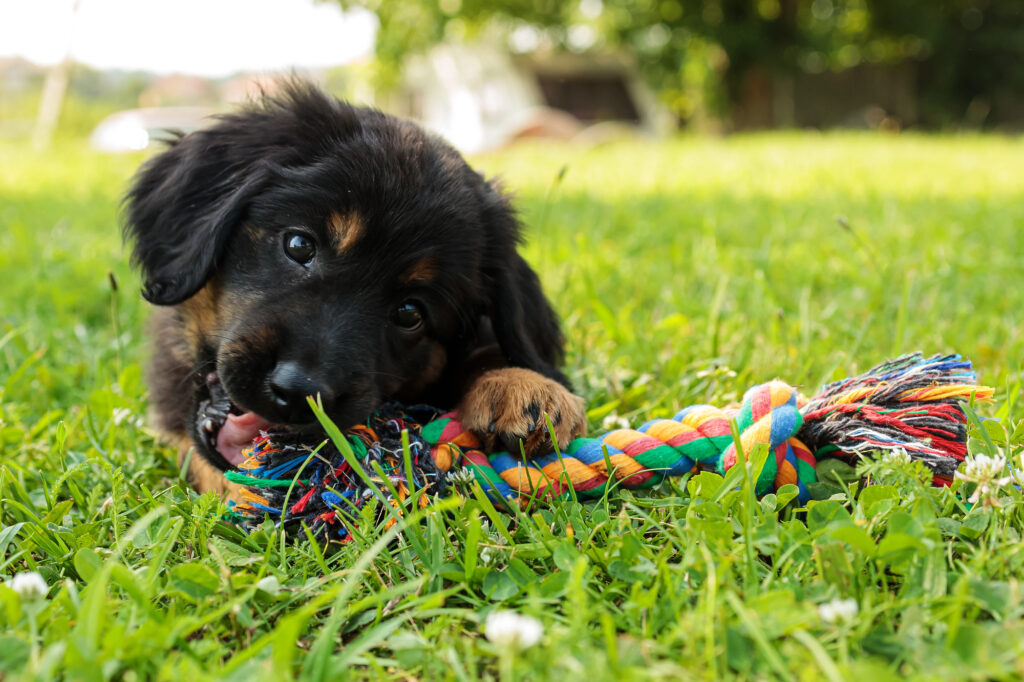
How Do I Stop My Pet From Chewing Everything?
Chewing is a natural behavior, but you can guide it toward safe outlets.
About 2.5 percent of dogs chew soft household items like pillows or clothes every day, with younger dogs being more likely to do it.
The key is to provide the right chew toys, redirect unwanted chewing, meet your pet’s physical and mental needs, and manage their environment.
With patience and consistency, most pets can learn what’s okay to chew and what’s off-limits.

Boarding Clients!*Discount does not apply during holiday/peak rate periods.

Key Summary:
To stop your pet from chewing, give them safe chew toys, redirect unwanted chewing, keep them active and mentally engaged, remove tempting items, and use safe deterrents. For persistent or anxiety-related chewing, get advice from a vet or animal behaviorist.
Why Pets Chew (and Why It’s Normal)
Pets chew to explore their environment, relieve teething discomfort, reduce stress, and keep their jaws strong. It’s a normal behavior, but without guidance, it can become destructive.
Chewing is how many animals interact with their surroundings.
For puppies and kittens, it’s part of growing up. For adult pets, it can be a way to release energy, ease anxiety, or simply enjoy a satisfying activity.
When chewing is directed at safe toys, it can help clean teeth, strengthen jaw muscles, and provide mental stimulation. Problems arise when pets don’t know the difference between a chew toy and your favorite shoes.
Understanding the Root Cause
To stop destructive chewing, you need to understand the underlying reasons. Common reasons include teething, boredom, anxiety, lack of appropriate toys, and medical issues.
Here are the main triggers, explained:
Teething discomfort: Young pets chew to soothe sore gums during tooth development.
Boredom or under-stimulation: Without enough activity, pets look for their own entertainment.
Anxiety or stress: Chewing can be a self-soothing behavior when they feel uneasy.
Lack of chew-appropriate outlets: If they don’t have toys they like, they’ll find their own.
Nutritional or medical issues: Deficiencies or dental pain can change chewing habits.
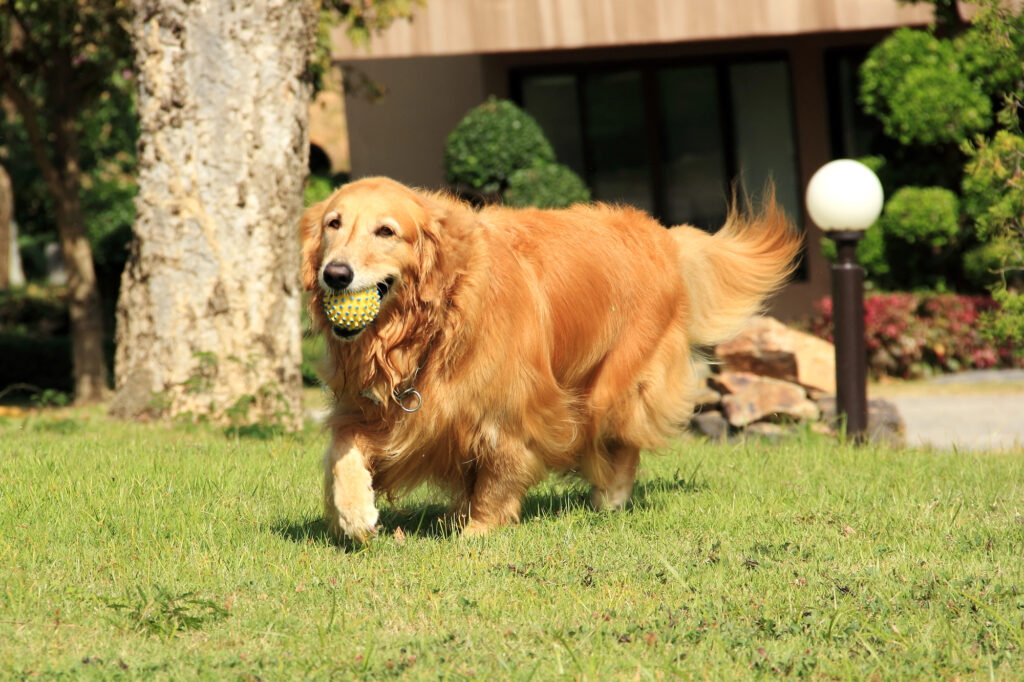
How to Stop Your Pet From Chewing Everything
Stopping unwanted chewing starts with giving your pet safe chew options, redirecting them when they choose the wrong item, providing enough exercise and enrichment, pet-proofing your space, and using safe deterrents when needed.
Here’s how to put that into action:
Step 1: Provide the Right Chewing Outlets
Safe chew toys give pets an approved way to satisfy their chewing instinct.
Choose toys designed for your pet’s size, jaw strength, and chewing style. Strong chewers often need thick rubber or nylon, while gentler chewers may prefer plush toys (only for supervised use).
Offer a mix of textures, rubber, rope, and fabric, to keep chewing interesting.
Rotate toys every few days so they feel “new” again. Food-stuffable toys like Kongs can be filled with wet food, peanut butter, or frozen broth for a long-lasting challenge.
Avoid unsafe items such as cooked bones or rawhide, which can splinter, cause choking, or lead to intestinal blockages.
Step 2: Redirect Inappropriate Chewing
Redirection teaches pets what to chew instead of punishing them for getting it wrong.
If you catch your pet chewing something off-limits, calmly interrupt and swap it for an appropriate toy.
Praise them immediately when they accept it. This helps them link good choices with rewards. Teach commands like “leave it” or “drop it” for situations where you can’t physically intervene.
Keep high-value treats on hand so trades feel like a win for your pet. Avoid chasing; many pets view that as a game, and it can encourage the behavior.
Step 3: Increase Physical and Mental Stimulation
Adequate exercise reduces chewing by lowering boredom and excess energy.
Match activity levels to your pet’s breed, age, and health.
For dogs, this could mean brisk walks, fetch sessions, or supervised play at a dog daycare. For cats, interactive toys, climbing trees, and hunting-style games work well.
Mental stimulation is just as important; puzzle feeders, trick training, scent games, and short obedience sessions keep their minds engaged and less likely to seek entertainment through chewing.
Step 4: Pet-Proof Your Space
Managing the environment prevents chewing before it starts.
Remove or secure tempting items like shoes, cords, children’s toys, and remote controls. Use baby gates or exercise pens to block off access to rooms where your pet might find trouble.
If your pet is crate-trained, the crate can be a safe, comfortable place when you’re away.
Always make sure they have fresh water, a soft bed, and safe toys inside their crate or playpen.
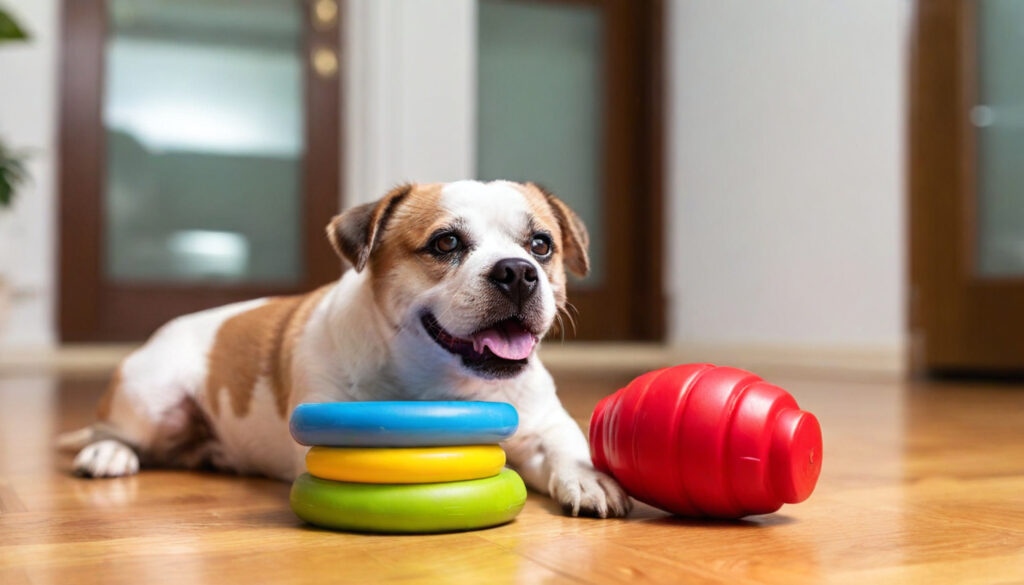
Step 5: Use Safe Deterrents
Deterrent sprays make off-limit items less appealing.
Pet-safe bitter sprays can be applied to furniture legs, cords, or other frequently targeted spots.
Always supervise the first use to ensure your pet reacts appropriately; some may ignore deterrents entirely.
Follow product instructions for reapplication, as many lose potency over time. Remember, deterrents should support training, not replace it.
Step 6: Address Special Cases
Teething puppies chew to relieve gum discomfort. Offer frozen rubber toys or chilled wet washcloths (supervised) to soothe pain.
Anxious pets may chew as self-soothing. Build predictable daily routines, provide calming spaces, and consider dog daycare for extra stimulation. A certified trainer or behaviorist can help with separation anxiety.
Persistent chewers might need a multi-pronged approach: increased enrichment, dietary review for nutrient deficiencies, and a veterinary dental exam to rule out pain.
Does Punishing Work?
Punishment rarely stops chewing and can make the problem worse. Pets do not connect past actions with delayed scolding, so they may become fearful without understanding what they did wrong.
Instead of punishment, focus on guiding the behavior. Redirect your pet to an appropriate toy, reward good choices, and manage the environment to prevent mistakes.
Positive reinforcement builds trust and teaches your pet what to do, rather than just telling them what not to do.
Teaching What to Chew
You can’t just tell your pet what not to chew, you have to show them what’s okay. Consistent training builds habits that last.
Steps to Teach Appropriate Chewing
- Step 1:Pick specific chew toys that are clearly different from household items.
- Step 2:Introduce the toy when your pet is relaxed, and encourage them to explore it.
- Step 3:Praise and reward them when they interact with the toy.
- Step 4:If they start chewing something inappropriate, calmly remove it and replace it with the approved toy.
- Step 5:Repeat this process consistently until they automatically choose their own toys.
- Step 6:Rotate toys regularly to keep them appealing.

When to Seek Professional Help
If chewing is excessive, damaging, or linked to anxiety or health issues, it’s time to consult a veterinarian or certified animal behaviorist.
Sometimes, chewing is more than a habit; it can be a symptom of an underlying problem.
Medical issues like dental pain, nutritional deficiencies, or digestive discomfort can all lead to increased chewing. In these cases, only a vet can identify and treat the root cause.
If your pet’s chewing stems from anxiety, fear, or behavioral challenges, a certified trainer or animal behaviorist can help create a structured plan to address it.
Professional support ensures you’re not just managing the symptoms, but solving the real problem behind the chewing.
Conclusion
Chewing is a natural behavior for pets, but it doesn’t have to mean ruined shoes or damaged furniture.
By giving your pet safe chewing outlets, redirecting them when they make mistakes, providing enough exercise and mental stimulation, and managing their environment, you can guide this instinct in a positive way.
Pay attention to changes in chewing habits; they can signal health or emotional issues that need professional attention.
With patience, consistency, and the right approach, you can protect your home and give your pet a healthy, happy way to satisfy their need to chew.





